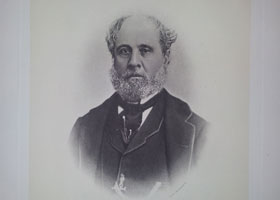The company of David Hutcheson & Co was established in 1851 with three partners, David Hutcheson (on the left), Alexander Hutcheson and David MacBrayne. This company took over the regular steamer service to the Inner and Outer Hebrides that had been previously operated by J & G Burns of which David Hutcheson had been local manager. The services provided included the lucrative Glasgow to Ardrishaig mail run and transporting passengers and freight to the outer western islands. But during the summer months, David Hutcheson & Co developed a tourist run to the western isles encouraging visitors to explore the wonders of the islands and as a result, developing towns and boosting the remote communities’ economies.
This company took over the regular steamer service to the Inner and Outer Hebrides that had been previously operated by J & G Burns of which David Hutcheson had been local manager. The services provided included the lucrative Glasgow to Ardrishaig mail run and transporting passengers and freight to the outer western islands. But during the summer months, David Hutcheson & Co developed a tourist run to the western isles encouraging visitors to explore the wonders of the islands and as a result, developing towns and boosting the remote communities’ economies.
Many of the ships owned by David Hutcheson & Co were constructed by J. & G. Thomson Ltd. as there was a long standing business arrangement and friendship between these two companies. The first such vessel was the PS Mountaineer purchased in 1852, closely followed three years later by PS Clansman and PS Iona. Hutcheson went on to buy three vessels named Iona from the Thomson yard. The first was in 1855 which was sold to Confederate forces in 1862 but sank before it had even left the Clyde. The second new and improved version (Iona II) was launched in 1863 and suffered a similar fate to its predecessor but was swiftly replaced with Iona III (main picture), launched in 1864 and continuing in service for the ferry company until it was scrapped in 1936.
Other long serving vessels built by J. & G. Thomson Ltd. for David Hutcheson & Co. were PS Chevalier, launched in 1866 and scrapped in 1927, and PS Gondolier, built 1866 and scuttled in Scapa Flow in 1939. SS Linnet was built in 1866 and was placed in use on the summer service through Crinan Canal until the vessel was sold in 1929. The final vessel built by J. & G. Thomson for David Hutcheson & Co. was the passenger cargo vessel Clansman, built in 1870.
Upon David Hutcheson’s retirement in 1876, and Alexander’s in 1878, David MacBrayne took exclusive control of the company from 1879 until his death in 1907. Through a succession of shared ownerships through the 20th century, and the company becoming nationalised in 1969, the company eventually developed into the business that it is today, Caledonian MacBrayne.